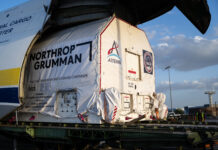NASA’s BlueFlux Initiative: Advancing Blue Carbon Management in Southern Florida
Introduction
The southernmost reaches of the Florida Peninsula are adorned with the intricate prop roots of red mangroves, scientifically known as Rhizophora mangle. These unique coastal trees serve as vital ecological players, providing shelter for fish to lay their eggs and offering nesting sites for birds such as the great blue heron and the roseate spoonbill. The mangroves’ complex root systems also trap organic matter and sediments, gradually expanding the coastline and protecting inland ecosystems from the sea’s erosive forces. While mangroves are essential architects of their environment, their ecological significance extends far beyond local boundaries.
Mangroves are recognized as a crucial carbon dioxide (CO2) sink, efficiently removing CO2 from the atmosphere. Estimates indicate that mangroves sequester CO2 ten times faster and store up to five times more carbon than rainforests and old-growth forests. However, these ecosystems are highly vulnerable to climate changes such as rising sea levels, hurricanes, and variations in ocean salinity. As these threats intensify, Florida’s subtropical wetlands and their critical role as carbon sinks face an uncertain future.
In response, NASA launched the BlueFlux Campaign, a three-year project running from 2021 to 2024, with a budget of $1.5 million. Operating under NASA’s Carbon Monitoring System, BlueFlux employs field, aircraft, and satellite data to study the impact of both natural and human-induced pressures on South Florida’s coastal ecology. The campaign involves a series of ground-based and airborne fieldwork efforts, aiming to develop a satellite-based data product that estimates daily rates of gas exchange between the surface and atmosphere across Florida and the Caribbean’s coastal ecosystems. According to Ben Poulter, the project lead at NASA’s Goddard Space Flight Center, the ultimate goal is to understand how blue carbon ecosystems fit into the global carbon market and to provide policy-related solutions for reducing atmospheric greenhouse gas concentrations.
This article delves into the BlueFlux fieldwork operations and explores how the project might refine global greenhouse gas budgets and support the restoration of Florida’s wetland ecology.
BlueFlux Ground-based Fieldwork
In the Everglades National Park, near the Flamingo Visitors Center, once stood a thriving mangrove population. Today, this area is a ghost forest, a stark reminder of Hurricane Irma’s impact in September 2017. The hurricane’s violent winds and storm surge devastated vast portions of the mangrove forest. While most of Florida’s mangroves recovered, some areas, like this one, have shown little to no regrowth seven years later.
David Lagomasino from East Carolina University, who participated in BlueFlux’s fifth fieldwork phase, expressed doubts about the mangroves’ recovery. His team focused on understanding how changes in wetland ecology affect CO2 and methane (CH4) sequestration and emission rates. In degraded areas like ghost forests, CO2 uptake declines while CH4 production increases, potentially amplifying the atmosphere’s heat-trapping ability.
In the Everglades, flux measurements rely on eddy covariance towers, which are part of the National Science Foundation’s Long-Term Ecological Research Network. These towers, like the one at Shark River Slough site 6 (SRS-6), continuously measure wind velocity, temperature, humidity, and trace atmospheric gases such as CO2 and CH4. These measurements collectively enable the calculation of flux, or the exchange of gases between the ecosystem and the atmosphere.
Gathering Data by Hand
To fill data gaps between the towers, researchers like Lagomasino collect data manually. Equipped with tools like the Russian peat auger, they extract core samples from the Everglades’ peat soils. These samples provide insights into carbon accumulation over centuries, as each core represents years of organic matter buildup. By analyzing these samples, researchers hope to understand how environmental factors like water salinity and temperature influence carbon sequestration rates.
Coastal wetlands, although covering less than 2% of the Earth’s land surface, store a disproportionate amount of blue carbon – carbon stored in marine and coastal environments. In the Everglades, quick-growing vegetation contributes to this carbon accumulation. The carbon captured through photosynthesis is stored in plant tissues, which eventually become part of the soil as organic matter. Wetland conditions, including water levels and oxygen availability, influence the balance of microbial populations that decompose organic material and release CO2.
Additional Fieldwork Teams
Lola Fatoyinbo from NASA’s Goddard Space Flight Center and Peter Raymond from Yale University led teams collecting forest inventory data in areas with varying levels of vegetation health. Using terrestrial laser systems and spectroradiometers, they mapped forest structure, species composition, and environmental variables. By measuring gas exchange rates at specific points, such as mangrove breathing pores and root systems, researchers aim to link these variables to flux.
The resulting data is stored in NASA’s Oak Ridge National Laboratory Distributed Active Archive Center, accessible to scientists monitoring trends. Early findings confirm that wetland soils naturally release CH4, a potent greenhouse gas, as a byproduct of microbial activity.
Airborne Research Teams Measure GHG Flux from Above
Despite extensive ground-based data, understanding the entire ecosystem’s influence requires airborne measurements. Between 2022 and 2024, the BlueFlux team conducted over 34 flights, collecting flux data using the CARAFE (CARbon Airborne Flux Experiment) payload. This innovative technique, involving cavity ringdown spectroscopy, measures GHG concentrations by analyzing how light interacts with gas molecules.
Airborne measurements offer a broader footprint compared to flux towers, enabling comparisons between aerial and ground-based data. The team’s challenge is ensuring airborne observations align with ground measurements. By overlaying flight paths with detailed maps of surface properties, researchers can attribute fluxes to specific sources.
Data Upscaling – Making Daily Flux Predictions from Space
Combining ground-based and airborne data, BlueFlux provides a framework for developing a regional image of GHG flux. Cheryl Doughty from GSFC is training a remote-sensing data product, Daily Flux Predictions for South Florida, using machine learning algorithms. This model relies on MODIS surface reflectance data to make flux predictions.
MODIS, an instrument on NASA’s Terra and Aqua satellites, offers over 20 years of daily data, allowing researchers to track changes in response to environmental processes. The resulting flux data will help explain how factors like sea-level rise, land use, and natural disturbances affect carbon sequestration.
Conclusion – The Future of Flux
As the Intergovernmental Panel on Climate Change (IPCC) refines global carbon budgets, accurately representing wetland ecosystems is crucial. Early estimates suggest that while South Florida’s wetlands emit CH4, they provide a net climate benefit by removing more greenhouse gases than they produce.
The BlueFlux initiative’s ongoing efforts, including future fieldwork deployments, aim to expand this research to the Caribbean and beyond. By contributing to a better understanding of global carbon markets, NASA’s BlueFlux Campaign seeks to inspire further investment in blue carbon stocks, ultimately supporting climate mitigation efforts.
For more information on the BlueFlux Campaign, visit the official NASA Earth Science page.
For more Information, Refer to this article.


































![Samsung’s Breakthrough Fuels Progress in Science and Industry: Interview How Samsung’s Engineering Feat Became a Catalyst for Scientific and Industry Advancement [Interview on Real Quantum Dots Part 2.]](https://www.hawkdive.com/media/samsung-tvs-and-displays-samsung-quantum-dots-technology-qled-tvs-quantum-dots-experts-interview-par-218x150.jpeg)